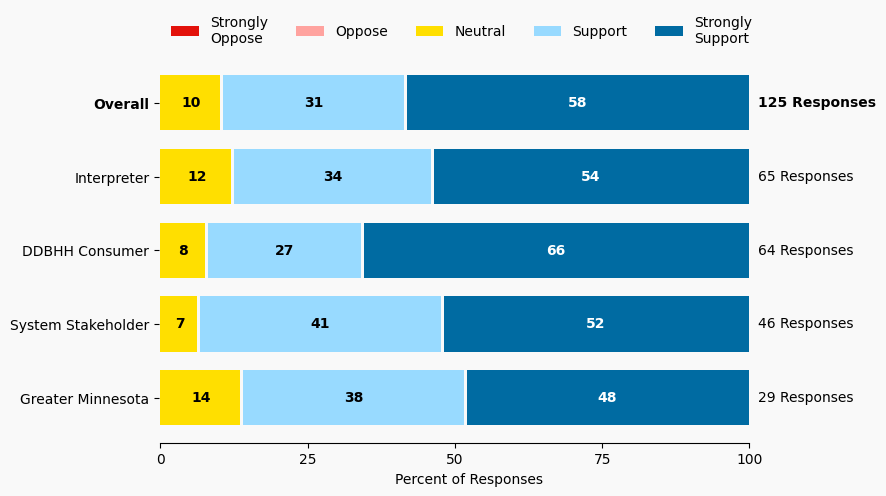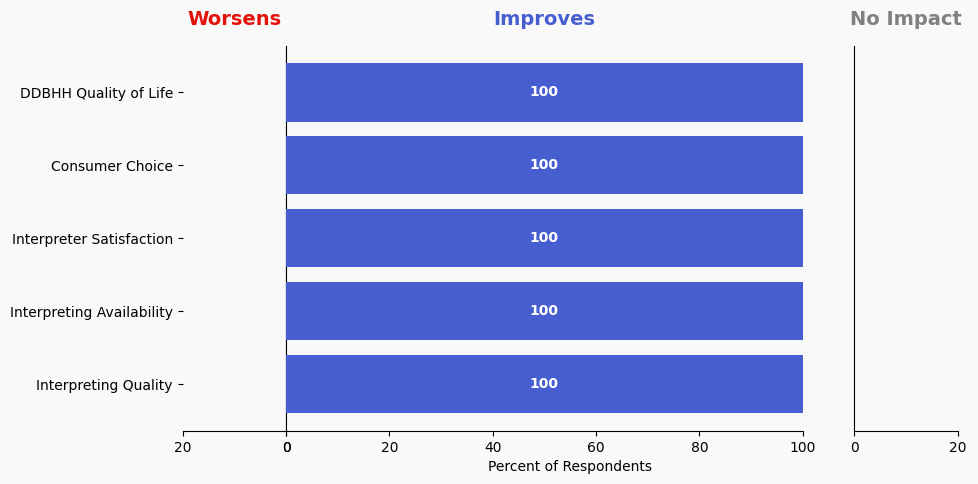59 Enhance Broadband Internet Access in Greater Minnesota
Issue: Broadband internet access in rural areas is often insufficient for high quality video capabilities needed for effective interpreting via video.
Proposed Solution: Commission and partner entities select and send representatives to the State of Minnesota, DEED Office of Broadband Development public meetings to advocate for DDBHH issues.
Expected outcome: With greater broadband internet access in rural areas, receiving VRI and VRS interpreting services will provide greater access for DDBHH Minnesotans in rural areas. Working interpreters in rural areas will have more options for video remote work.
Who is impacted: Consumers in Greater Minnesota; interpreters in Greater Minnesota
Update: Consider satellite internet as an option.
Timeline: 6 months

Summary of Support Image Description
The stacked bar charts show how respondents rated their level of support and the total number of responses. The percentage for the five support levels is shown from left to right: Strongly Oppose (Dark Red), Oppose (Light Red), Neutral (Yellow), Support (Light Blue), and Strongly Support (Dark Blue).
Respondents may identify with multiple subgroups. The overall level of support is:
Overall
Strongly Oppose: 0%
Oppose: 0%
Neutral: 10%
Support: 31%
Strongly Support: 57%
Click to see the detailed image description for each subgroup.
Interpreter
Strongly Oppose: 0%
Oppose: 0%
Neutral: 12%
Support: 34%
Strongly Support: 54%
Greater Minnesota
Strongly Oppose: 0%
Oppose: 0%
Neutral: 14%
Support: 38%
Strongly Support: 48%
DDBHH Consumer
Strongly Oppose: 0%
Oppose: 0%
Neutral: 8%
Support: 27%
Strongly Support: 66%
System Stakeholder
Strongly Oppose: 0%
Oppose: 0%
Neutral: 7%
Support: 41%
Strongly Support: 52%
Overview of Respondents Opting for In-Depth Solution Analysis
After indicating their support level, 0% of the 125 respondents opted in to further assess whether the solution would worsen or improve on five metrics. Of the opt-in reviewers (1 respondents), 100% supported the solution, 0% were neutral on the solution, and 0% opposed the solution.
The remaining 124 respondents did not opt in to further assess the solution. Of these people, 89% support the solution, 10% were neutral on the solution, and 0% opposed the solution.
Reviewer Evaluation of Solution Effectiveness

Solution Effectiveness Image Description
The stacked bar charts show how respondents assessed the effectiveness of this solution based on five metrics. For each metric, the percentage of respondents is shown from left to right: Worsens (Red), Improves (Blue), No Impact (Gray).
DDBHH Quality of Life
Makes It Worse 0%
Makes It Better 100%
No Impact 0%
Interpreter Satisfaction
Makes It Worse 0%
Makes It Better 100%
No Impact 0%
Consumer Choice
Makes It Worse 0%
Makes It Better 100%
No Impact 0%
Interpreting Availability
Makes It Worse 0%
Makes It Better 100%
No Impact 0%
Interpreting Quality
Makes It Worse 0%
Makes It Better 100%
No Impact 0%
Reviewer Feedback and Insights
Interpreter
No comments were submitted.
Deaf, DeafBlind, Hard of Hearing
No comments were submitted.
System Stakeholder
One comment from a System stakeholder raised a question on whether efforts to enhance broadband access in Greater Minnesota are already underway, separate from the initiative to increase interpreting availability.
PREVIOUS SOLUTION
Issue: Interpreter shortage; amplified in Greater Minnesota
NEXT SOLUTION
60 Regulate the Use of Video Remote Interpreting (VRI) in Critical Settings
Issue: VRI is often stated as the only choice a DDBHH Minnesotan has for their communication access. Budget and lack of awareness often drives provider decisions to make contracts that only offer VRI.
Leave a Reply